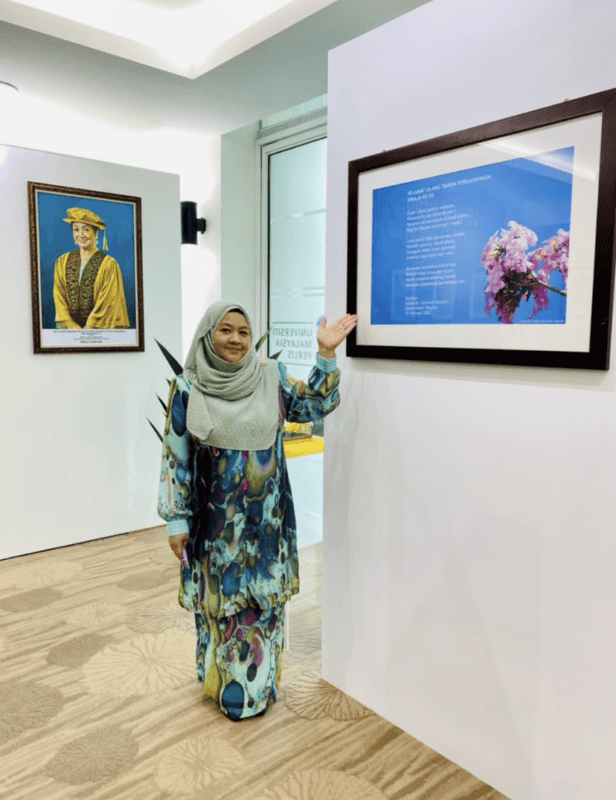Libraries Investing Ahead: An Interview with Mazmin Mat Akhir
“Service is our watchword,” says university librarian Mazmin Mat Akhir, reflecting the centuries-long mission of libraries to serve humanity. She is this month’s featured guest in our blog series.
Click here to catch up with previous instalments of Libraries Investing Ahead
With over three decades of professional experience, Mazmin Mat Akhir from Universiti Malaysia Perlis in Malaysia is well acquainted with both the difficulties and rewards of managing a university library.
For this month’s interview in the Librarians Investing Ahead series, Linda Bennett from Gold Leaf spoke with Mazmin about budgetary and other challenges, collaboration efforts, the purpose of the library, and much more.

Linda Bennett: Could you tell us a little about Universiti Malaysia Perlis (UniMAP)?
Mazmin Mat Akhir: Universiti Malaysia Perlis, also widely known in Malaysia as UniMAP, is one of the four universities under the Malaysian Technical University Network that serve as high TVET institutions. In August 2025, UniMAP received the TVET Higher Education Provider (PPT) Excellence Award at the Malaysian Qualifications Agency (MQA) Awards 2025.
Founded in 2002, the university focuses particularly on engineering programs and related disciplines aimed at enhancing the employability and entrepreneurial skills of engineering students. Currently, the university hosts more than 13,000 students in both undergraduate and postgraduate programs. The university’s strategic plan comprises nine thrusts, including research excellence, supported by strong centres of excellence across competitive research areas. As of now, UniMAP has accumulated a total of more than 18,000 indexed publications in Scopus. We are proud to celebrate the university’s performance ranking. It is in the top 300 universities listed by the Times Higher Education (THE) Impact Rankings for 2025.
LB: Libraries across the world are experiencing budget squeezes at the moment, but in some countries the cuts have been particularly deep. Could you tell us what your main budgetary challenges are and how you alleviate them?
MMA: Our biggest challenge is to provide high-impact resources for our university community that support their teaching, learning and research activities. The library prioritizes the funds available for collection management, which are meant to cover subscription renewals, the acquisition of research tools, and providing students with access to electronic textbooks. Recently, we optimized evidence-based acquisition as one of many strategies aimed at achieving sustainability with a modest budget. Working through our national consortium has also helped public universities in Malaysia to keep paying subscriptions for several critical resources.
“We continue to lobby for a significant amount of extra budget to create more up-to-date facilities for the university community. ”
Another budgetary challenge is to maintain the library’s facilities to an acceptable standard. Libraries require a significant budget for facility maintenance and enhancement if they are effectively to attract students and faculty members. We seek out collaborative projects within and outside the universities to develop new facilities in line with the users’ requests and demands. Several facilities, including the library’s makerspace and marketplace, are the outcome of collaborative projects.
We continue to lobby for a significant amount of extra budget to create more up-to-date facilities for the university community. Ideally, we need budget for the installation of smart TVs, all-in-one computers in all meeting and discussion rooms. an LED screen for the auditorium, and the establishment of new social science and humanities libraries on another campus. The university actively supports the library’s mission to serve as a central hub for the university community in all intellectual and knowledge-sharing initiatives.
A new service the library now offers is to aid researchers in open access publishing by providing free and discounted APCs, in order to enhance publication output and impact for the university. Also, in 2024 the library and some university researchers successfully developed a virtual research gallery on the university website, which is now available to the global research community.
LB: Please describe some recent fund-raising activities – if you can also tell us about some successes, that would be of great interest to readers.
MMA: The library keenly pursues fund-raising activities that allow us to offer more to our community, both on and off campus. One recent project, EDUSTREAM, is a service for schools. It is the product of financial contributions from at least four institutions and both internal and external agencies. EDUSTREAM enables us to offer robotics, 3D workshops and creative projects to more than 500 students across 102 schools in the state.
We also collaborate with women’s societies to organise high-tea charity events that feature well-known performers. The first of these, held in February 2023, successfully generated a significant sum of money via sponsorship and donor contributions. It is through such initiatives that the library manages to provide fully-funded therapy sessions for autistic children in the community. In response to our continuous CSR [Corporate Social Responsibility] program for improving the lives of autistic children, we have received funds to develop an open gym which provides them with access to physical and sensory therapy equipment.
The CSR program has helped the library connect with many organizations, leading to numerous collaborative projects that benefit both the university community and the community at large.
Our guiding principle is that today’s academic libraries must not only fulfil their core purpose but also serve the broader community. This principle has led to strong collaboration with various stakeholders and also demonstrates the uniqueness and strength of libraries, especially within the university ecosystem.
LB: Besides financial challenges, what other difficulties do you face?
MMA: Our primary challenge is to demonstrate the value of libraries to stakeholders. The library has ventured into many supply initiatives, such as exploring the potential of the consortium model, implementing transformative agreements, and setting up the read and publish model with major publishers. These initiatives clearly demonstrate the contributions of the library beyond teaching, learning and research activities. We continually expand our role in publishing by supporting both young and high-impact researchers in their publication efforts, and by doing this we contribute to the university’s significant growth in research performance.
“Libraries must work collaboratively to promote their values, which cannot be accomplished by a single library alone, but rather through a collective effort, especially.”
However, there is still a strong perception that libraries are locked in to the traditional role of managing lending services and shelving printed books. It is hard to break away from this, especially as this view is reinforced by senior academics who see the library mainly as a resource for supporting their work. Of course it does do this, but it also does many other things as well.
Libraries must work collaboratively to promote their values, which cannot be accomplished by a single library alone, but rather through a collective effort, especially via associations and consortia.
LB: What are your future plans for developing your role in the library and the services the library offers?
MMA: I have always seen the library as a “mall” that serves products that are a right fit for each customer, with some added intangible benefits. Despite the variety of online shopping platforms, customers still visit malls to socialize, discover exciting new services, and engage in real conversations in real surroundings. If libraries are seen though a similar prism of service and socialising, their ability to charm becomes clear. It harnesses a powerful mix of the expertise of the librarians, a portfolio of relevant services, and an exciting experience that fosters creative teaching, learning and research activities.
“Future academic librarians will succeed by their ability to create both exciting bricks-and-mortar libraries and comprehensive digital libraries.”
This is not to denigrate the importance of electronic resources and other virtual tools that facilitate teaching, learning, and research. Future academic librarians will succeed by their ability to create both exciting bricks-and-mortar libraries and comprehensive digital libraries.
LB: A little about yourself. How long have you been a librarian? Where did you train? How long have you been at Unimap? How would you like to develop your career? A few personal details if you wish – e.g., hobbies, favourite books.
MMA: I have 31 years’ experience as a librarian. I have worked at three distinguished universities, culminating in the last 10 years as the Chief Librarian at University Malaysia Perlis. I am passionate about sketching, and the library has developed many facilities that are based on my sketches. For career development, my primary goal is to write reference books for future librarians and contribute to a positive and competitive image of university libraries.
LB: In the USA – and, because of that, in many other parts of the world – higher education has been under attack in recent months. What do you think will happen to higher education – and by extension, the libraries that serve universities – in the next 2 – 3 years? What can librarians do to maximise their work?
MMA: In Malaysia, the value of higher education is still recognized and generally accepted as a credible and reputable way of developing skills for the future. Students continue to pursue higher education, and universities remain committed to fulfilling the dreams of the young generation. Through lifelong learning, universities collaborate with employers, employees, and industries to deliver improved qualifications, new skills, and cutting-edge technologies, thereby enhancing competitiveness. We are committed to establishing ourselves as an international education hub, developing an ecosystem that provides international and local students with valuable experiences.
And the future of the library? We hear about libraries losing their strength and impact due to various factors, including technology disruptions, new technologies, new media, new lifestyles, and new expectations. Having spent 30 years in this respected institution (the university library) at various universities, I continue to observe students and staff entering libraries for a range of reasons, beyond just studying. They step into the libraries to meet people, engage in intellectual discourse, discuss matters with industry players, interact with their lecturers, and have fun at the library (we supply coffee, music, and cultural shows).
LB: What can librarians do to maximise their work?
MMA: Libraries have been serving human beings for centuries. Our performance is consistently tied to how well we understand our customers. Service is our watchword.
Check out the whole blog series
[Title Image by Kobus Louw/E+/Getty Images]
